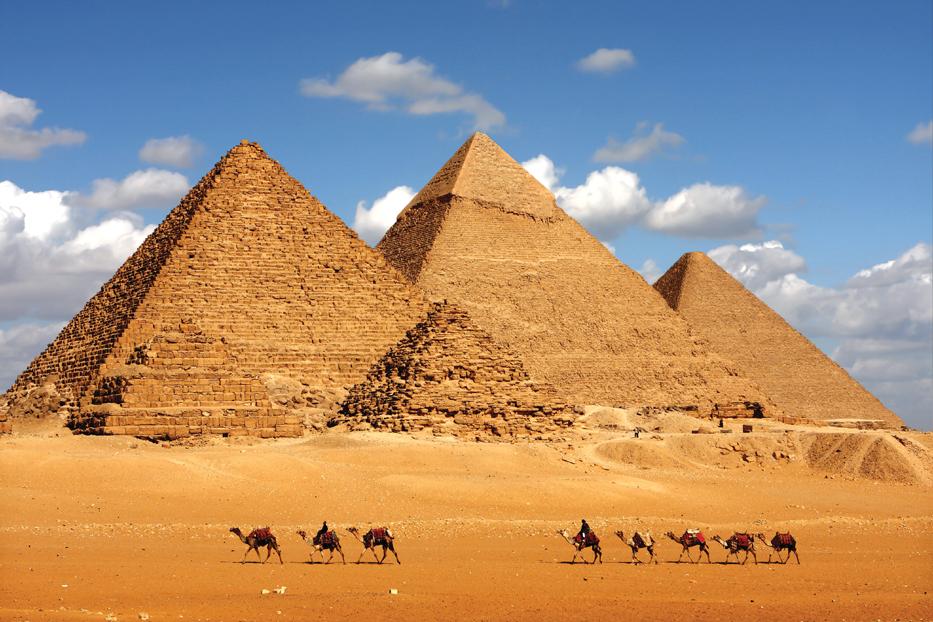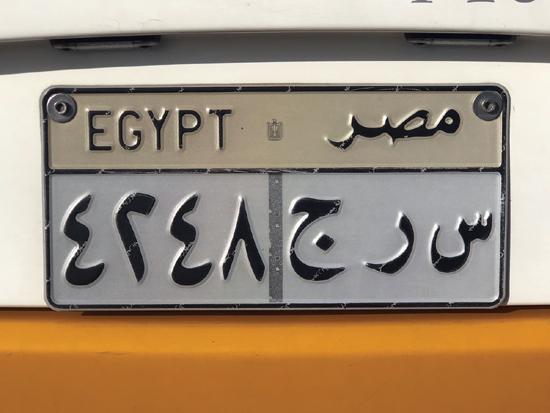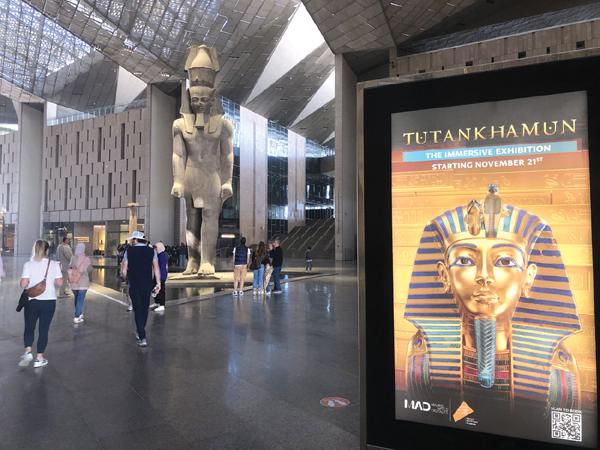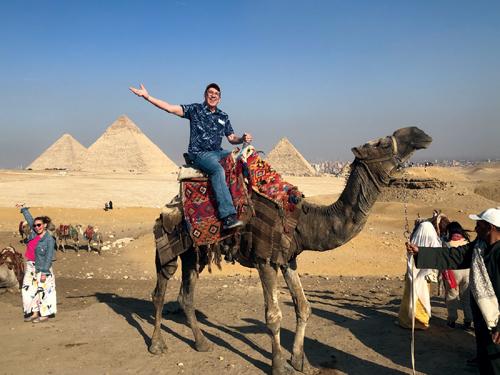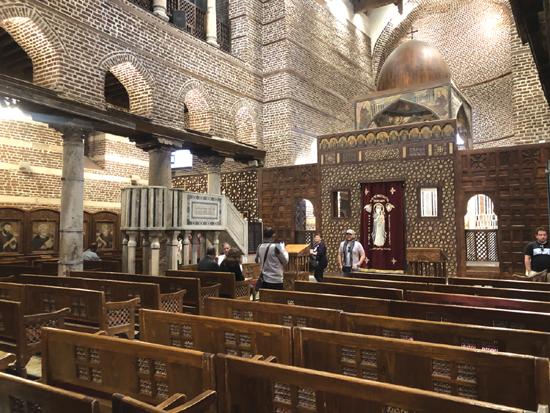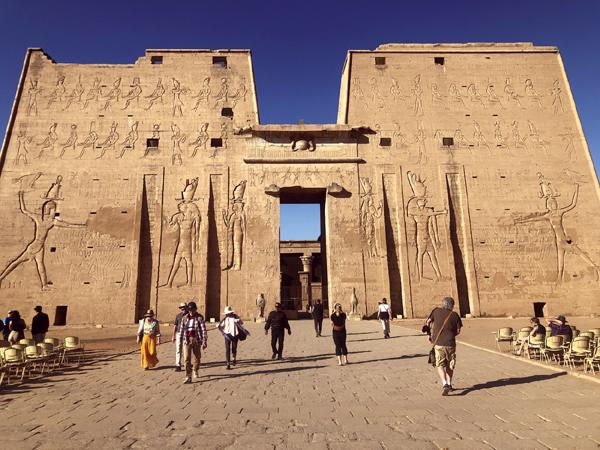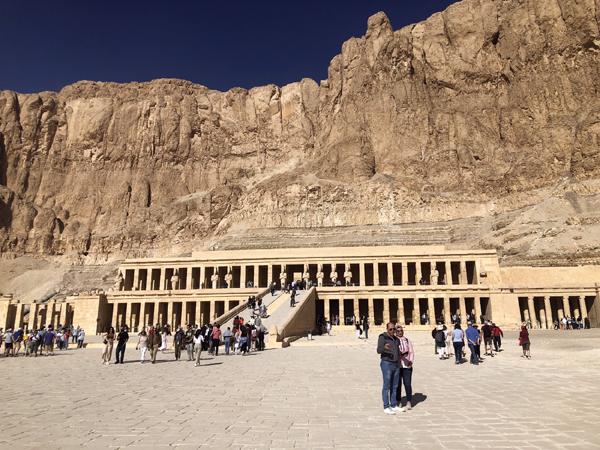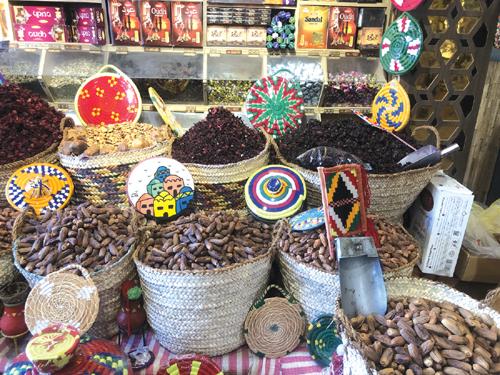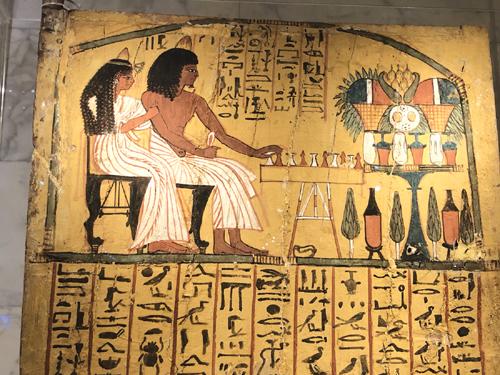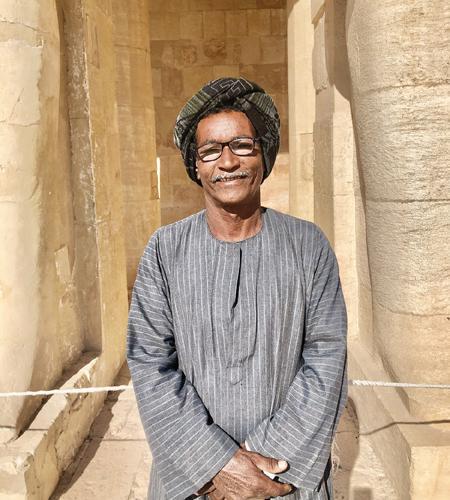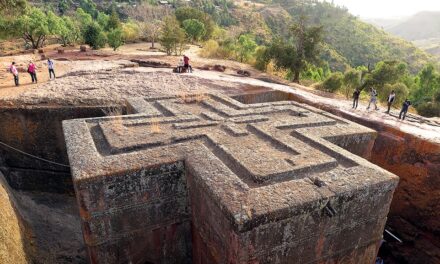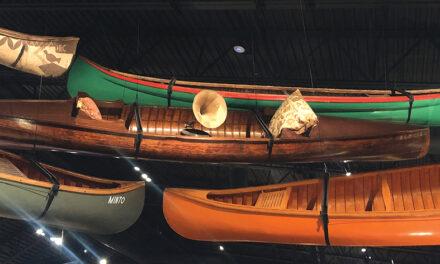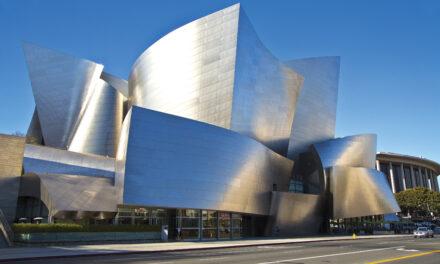Egypt
The Splendors of Egypt Cast a Magic Spell
Article and photography by Randy Mink
Egypt! After years of daydreaming about doing the big trip, I finally made it to the land of the Pyramids and King Tutankhamun, Cleopatra and Queen Nefertiti.
In the travel world, the term “bucket list” may be overused, but Egypt had always been on my personal agenda, and now it’s been checked off. This fascinating desert country straddling Africa and Asia was everything I had hoped it would be.
My small Goway Travel group spent a week touring Cairo, Alexandria, and the ancient temples and tombs of southern Egypt. A real highlight was a three-night cruise from Aswan to Luxor on the Nile, the world’s longest river. See my Nile cruise article on page 60.
Goway’s partner on the ground in Egypt is Emeco Travel, whose staff goes above and beyond to make the experience seamless. Each of us on the trip appreciated Emeco’s meet-and-greet service at the Cairo airport. After going through customs, our group was ushered to a waiting mini-bus for the 45-minute, late-night drive to Four Seasons Hotel Cairo at The First Residence, a 5-star property attached to a luxury shopping mall in Giza, a separate city of 2.5 million.
Grand Egyptian Museum
On our first morning, we got a peek at the brand-new, partially opened Grand Egyptian Museum (GEM), a $1 billion complex that has been in the works for years. With moving walkways through cavernous galleries—not to mention shops, a food court and children’s museum—it claims to be the world’s largest archaeological museum devoted to a single civilization.
We were blown away by the museum’s King Tutankhamun Immersion Experience, a half-hour visual extravaganza in a rectangular theater swirling with digital images that tell the story of the “boy king,” whose tomb was only discovered 102 years ago. Eventually, King Tut relics and other treasures now at various Egyptian museums will make their way into GEM’s spaces. The stunning building, across the river from Cairo on the desert plateau above the western edge of Giza, slopes toward the Pyramids of Giza, just a mile away, echoing their architecture.
Pyramid Scheme
What a thrill it was to come face to face with the trio of mighty Pyramids, the only survivors among the Seven Wonders of the Ancient World. Built as pharaohs’ tombs 4,500 years ago, they were the tallest structures on earth until the 14th century and, remarkably, have remained in a good state of preservation. It’s possible to go inside the tomb chambers, but we were told it’s dark and claustrophobic with not much to see.
The mood at the Pyramids, the very symbol of Egypt, is far from reverent, however, as hundreds of vendors hawking souvenirs and camel and horse cart rides create a circus-like atmosphere. After a patio lunch at Khufu’s restaurant, our Goway gang went to a panoramic lookout point affording views of all three monuments. Each of us paid $2 to pose atop a camel with the Pyramids as a backdrop. Before leaving the Giza plateau, we got a close-up look at the Sphinx, the iconic sculpture combining the head of a man with the haunches of a lion.
Cairo Sightseeing
Our Cairo visit also included the National Museum of Egyptian Civilization, which covers every period in the country’s history. The dark, eerie lower level contains the mummified remains of 20 kings and queens from antiquity, many with blackened heads, feet and arms poking out of the fabric.
In Old Coptic Cairo, we toured medieval Coptic Orthodox churches and the 9th century Ben Ezra Synagogue. It’s said that the Church of St. Sergius and St. Bacchus is built over a cave that sheltered Mary, Joseph and the infant Jesus for three months when they fled to Egypt to escape persecution from the Roman king of Judea.
On the outdoor terrace of Hill-Top Restaurant at Al-Azhar Park, an oasis of greenery overlooking Old Cairo, our Goway group then feasted on a lunch of chicken and lamb kebabs, rice and french fries. We dipped puffy pita bread into creamy sauces—tahini, hummus and babaganoush.
Mesmerizing Marketplace
To me, Cairo, a city of 22 million, is all about street life, and there’s no better place to dive into the fray than labyrinthine Khan-el-Khalili Market, a typical Arab bazaar populated by stray cats, folks in traditional dress, boys carrying trays of bread on their head—and plenty of tourists. Shopkeepers deliver well-honed sales pitches, asking passersby to “take a look.”
Along Khan-el-Khalili’s warren of alleyways, hole-in-the-wall shops brim with brass tea sets and sparkly belly dancing outfits, gold and silver jewelry, embroidered dresses and handbags, perfumes and carpets. King Tut and Queen Nefertiti statuettes come in all sizes.
In a spice emporium with open sacks of dates, nuts, teas, herbs and various powdery cooking ingredients, the friendly owner opened jars of curry for me to smell. Another merchant, after selling me two T-shirts, insisted I see his silver shop next door. From an antiques dealer I snared my find of the day—a weathered Pepsi sign in Arabic that I now display at home with my other soft drink memorabilia.
Chaotic, Congested Cairo
Cairo’s traffic-choked streets are a free-for-all. Expect to spend a lot of time in your bus or taxi because traffic moves slowly, sometimes not at all. With horn-honking motorists constantly changing lanes while somehow avoiding pedestrians who nonchalantly weave through the nonstop parade of moving cars, it’s a wonder we never saw an accident, though close calls occurred every few seconds. Watching your driver, seemingly calm and unflustered, deftly maneuver through the tangle of traffic is quite a show.
I like walkable cities, but Cairo is not one of them. Since there are very few stoplights to slow the steady streams of traffic, tourists don’t have many places where they can cross with confidence. We would often follow locals as they darted into the roadway, hoping for the best. In one instance, a man noticed our hesitation and led us across, returning to the other side after completing his good deed.
Call of the Nile
From Cairo our Goway group took an EgyptAir flight to Aswan, the starting point of our Nile River cruise to Luxor. The next three days were nicely paced, split between archaeological site visits, shopping stops and time to relax on the Sonesta St. George, a 5-star river ship.
After settling into our cabins and having lunch onboard, we were off to the Temples of Philae, a series of temples that were dismantled in the 1970s, removed from flood-ravaged Philae Island and rebuilt on nearby Agilkia Island. Along with our guide, Ramy Sakhry, we boarded motorboats for the short trip to the island in Aswan Lake, a body of water between the 1902 Aswan Dam and the High Dam, completed in 1972. Dedicated to the goddess Isis, the Temple of Isis was begun around 690 B.C. and for 700 years was the most important shrine in Egypt.
I’m glad I did a little reading about ancient Egypt before the trip. Knowing historical periods and names of certain gods, kings and queens prepared me for Ramy’s commentaries. All guides on Goway tours are certified Egyptologists.
Exotic Shopping
After the Temples of Philae, we were taken to two shops before going back to the ship. At both places we were seated on comfortable cushions in showrooms and served hibiscus tea while listening to sales spiels. Surrounded by bottles of essential and medicinal oils at Mohammed El Fayed Essence of Life Perfume Palace, we got a whiff of different scents applied to our wrists and forearms; some received neck and forehead massages using the oils. The lavender spray, we were told, promotes sleep and relaxation, while a few drops of clove oil in water not only helps to relieve toothache but stops vomiting and helps to curb the desire for alcohol and nicotine. From frankincense and myrrh to mint, eucalyptus and sesame oils, each elixir has some use in aromatherapy.
Then it was on to Al Attar Spices, where we were given tastes and smells of everything from ginger and ginseng to oregano and powdered mint.
I didn’t buy a single thing at the shops we visited but enjoyed the product demonstrations. These “commercials,” moreover, provided a welcome break from the history-heavy touring.
At an alabaster shop I got some good shots of turbaned artisans as they chiseled the stone. Salespeople at Sekhmet Papyrus Gallery showed us how papyrus leaves are processed and made into works of art. At Habiba Hand Weaving, many in our group bought Egyptian cotton textiles, and I photographed the weavers at their looms.
Noteworthy Temples and Tombs
Among the most photogenic sites we encountered was Edfu Temple, which we reached from the ship via horse carriage. One of the most striking and complete temples, the structure has survived so well because it was buried under debris for centuries until being discovered in 1860 by a French archaeologist. Begun in 237 B.C. under Ptolemy III, Edfu Temple was completed 180 years later by Ptolemy XII, the father of Cleopatra VII (played in the epic movie by Elizabeth Taylor). It is dedicated to the god Horus.
One could spend a week visiting the temple complexes clustered in and around Luxor, a Nile River city of 700,000 located 420 miles south of Cairo. Our Goway gang hit the highlights—Luxor and Karnak temples on the east bank and the burial places of New Kingdom kings and queens on the west bank.
In Valley of the Kings, where pharaohs were laid to rest in rock-cut tombs bedecked with gold and jewels, we were given a ticket good for entry into three of the eight tombs open to visitors. The chambers, decorated with hieroglyphics and paintings in various states of preservation, provided a good place to commune with the past and escape the desert heat.
On our February trip we enjoyed sunny days in the 70s (Fahrenheit), even low 80s, with nights and early mornings on the chilly side. I can’t imagine traipsing through the archaeological sites in the summer heat. Egypt is mostly desert; there is little shade.
Alexandria: The Second City
Our Goway journey wound down with a flight from Luxor back to Cairo and then a three-hour drive to the Mediterranean port of Alexandria, Egypt’s second-largest city (population 7 million). Though it was far from our favorite place on the tour, Alexandria impressed us with the Bibliotheca Alexandrina, a modern library complex inspired by the city’s original library and prominence as a center of learning in the ancient world. Among the library’s museums are ones devoted to art, antiquities and late President Anwar Sadat, who was assassinated in 1981.
Memorable group meals in Alexandria included a seafood lunch at the waterfront Fish Market and grilled specialties at Byblos, a Lebanese restaurant at the swank Four Seasons Alexandria Hotel at San Stefano, where we overnighted.
A Last Look at Cairo
In Cairo, the deluxe Fairmont Nile City pampered us on our final night. Since my flight home the next day was not until midnight, I had another 12 hours to see more of Cairo. In the morning I glimpsed the treasures of King Tutankhamun’s tomb at the Egyptian Museum, an old-school repository of antiquities. My afternoon was spent poking around the mosques and museums atop The Citadel, a fortified complex of museums and mosques affording fine views of the city below.
Go With Goway
Goway specializes in custom-designed trips for groups and individuals. It recently introduced Odysseys by Goway, a new line of small-group journeys (16 guests maximum) with guaranteed departure dates. One of those is the nine-day “Egypt Odyssey.”
The Toronto-based company takes globetrotters to 115 countries, and its website lists more than 1,500 suggested itineraries, 14 of them in Egypt. Egypt is often combined with countries like Jordan, Saudi Arabia, Dubai and Qatar.
With the expertise and years of experience offered by planners from Goway, the possibilities are endless for a Middle Eastern trip of a lifetime.

